IMS 2001: Chicken Little Was Wrong
Frank Bashore
Microwave Journal staff
How can the sky be falling on the RF/microwave industry when over 11,000 participants braved 100°+ heat to attend Microwave Week in Phoenix in May? IMS 2001 was the biggest and best symposium and exhibition yet, and the smiling faces of all that attended were a visible confirmation.
No one was quite sure what to expect as the show approached and rumblings of a business slowdown dominated conversation. A few companies even backed away thinking they would be super conservative and save their pennies for the rainy day sure to come. But in spite of a brutal spring heat wave and tough hotel accommodations, the Phoenix Civic Center was soon filled to capacity with enthusiastic visitors and delighted exhibitors. Five hundred and sixty four companies filled the spacious show floor, and over 3000 engineers attended the 363 technical paper presentations, 183 interactive forums and other technical sessions, and 20 workshops.
Samir El-Ghazaly, the 2001 International Microwave Symposium general chairman, and his staff are to be commended on hosting a superb event and packing it with interesting activities and lavish amenities. From the early morning free breakfast, through to the evening receptions and dinners, the attendees were made to feel this was a big party and they were the honored guests. The Technical Program co-chairmen, Vijay Nair and Chuck Weitzel, also did a fine job assembling an interesting program of presentations, short courses and interactive sessions aimed at today's leading edge technologies. With six parallel tracts, being selective was a must for symposium participants.
As in the past, the Radio Frequency Integrated Circuits (RFIC) Symposium, chaired by Sayfe Kiaei, and the 57th Conference of the Automatic Radio Frequency Techniques Group (ARFTG), headed by Charles Wilker, ran concurrent with the MTT-S Symposium. The RFIC Symposium began on Sunday and concluded on Tuesday in a joint RFIC/MTT-S session. ARFTG was held on Friday, May 25th, with a theme of "Best Practices and Strategies for RF Test." The industry exhibition ran Tuesday through Thursday, along with a number of the now popular Microwave Application and Product Seminars (µAPS).
The Technical Program
A record 930 papers were submitted earlier in the year, of which 511 were painstakingly selected for presentation. Continuing the trend of recent years, the vast majority of the presentations aimed at commercial applications of MMIC and leading edge semiconductor technologies. Wireless communications still dominated and CAD techniques were everywhere.
The Symposium opened, as usual, with a number of interesting Sunday workshops. Attendance at these interactive sessions was surprisingly high and remained so for the remaining workshops at the end of the week. The two dominant themes seemed to be CAD techniques and component design. In addition, there were five panel sessions covering RF CMOS for Bluetooth, one chip radio, automotive radar, industrial-university interactions and commercial use of the 92 to 96 GHz spectrum. Five short courses were offered covering fast-MOM and Green Function-based wavelet applications, RF power amplifiers, nonlinear measurement basics, MEMS and multicarrier signal description for linear amplifiers. The technical presentations included microwave photonics, medical applications, MEMS, antenna design, acoustic devices, transmission media issues, device modeling and simulation techniques, power amplifier characteristics, measurement techniques, optical broadband methods, wireless sensors, ferrite devices, microwave and millimeter signal sources and filters, device technologies and MMIC technologies, as well as many other interesting topics. There was truly something for everyone.
The RFIC technical program was comprised of 60 paper presentations in 14 technical sessions and an interactive forum. As the name implies, these sessions were focused mainly on integrated circuit issues and their applications. Friday's ARFTG conference concentrated mainly on microwave test and measurement issues, including accuracy, equipment selection and test methodology.
There were 41 separate µAPS seminars that provided technical information on commercially available state-of-the-art products, serving as a technical forum for exhibitors. These popular presentations covered CAD and simulation tools and techniques, and active and passive components and systems applications.
The MTT-S student paper competition presented the 26 semifinalist technical papers at interactive forums on Tuesday and Wednesday. Six papers were ultimately selected and prizes were awarded at a student awards luncheon on Thursday.
Highlights of the MWJ/MTT-S Reception
May 2124, 2001
 |
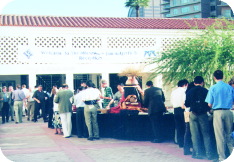 |
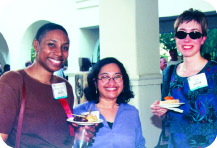 |
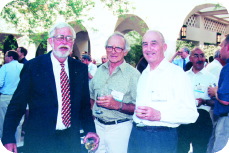 |
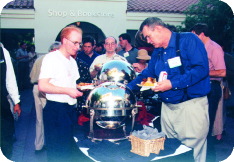 |
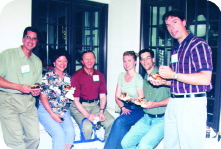 |
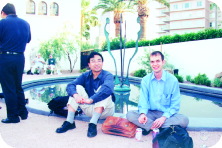 |
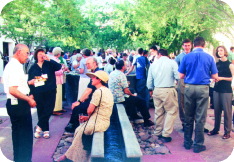 |
 |
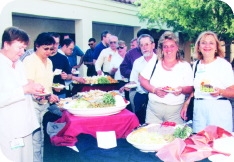 |
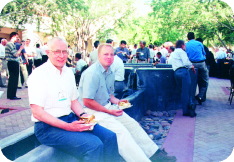 |
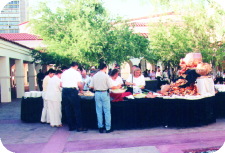 |
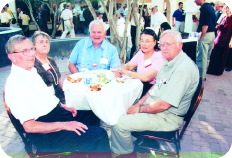 |
 |
Social Events
Monday evening's Microwave Journal/MTT-S reception officially kicked off the week's social program with a reception at the Heard Museum. Guests enjoyed the interesting Southwest artwork and artifacts on display in the museum, while becoming reacquainted with many old friends and colleagues. (A montage of photos from the evening appears on pages 26 and 27.) Although the evening remained quite warm, the refreshments were cool and food plentiful.
Throughout the week, there were a number of other receptions, including one at the Corona Ranch and Rodeo Grounds, where some of the guests learned how to rope a calf or ride a bucking barrel prior to feasting on a true Southwestern barbeque spread.
Wednesday's Awards Banquet was preceded by the Industry-hosted cocktail reception in the Hyatt hotel lobby. Wednesday also featured a reception for IEEE Women in Engineering at the Hyatt Regency.
The social program also contained many guest tours to surrounding area attractions that included overnight trips to the Grand Canyon and Sedona, as well as excursions to the Phoenix Art Museum, Boyce Thompson Arboretum and the Verde Canyon Train Ride, and a city tour of the Phoenix area.
The Industry Exhibition
This year's Industry Exhibition was the largest ever in terms of the number of booths and individual companies displaying their products. The Phoenix Civic Center provided one of the best facilities for such an event, with one large open hall that seemed to go on forever. It was no small task to walk its entire length visiting the many diverse company displays. If the industry is in a slump, nobody told the exhibitors or attendees. The mood was upbeat and getting to see a contact was a "wait your turn" affair almost everywhere.
Although it is impossible to highlight each new product offered by each exhibiting company, a small sample of these products follows.
Heading the list is Agilent Technologies' Performance Signal Generator (PSG) series of signal sources that provide high frequencies, wide bandwidths and complex modulation formats to help component manufacturers speed up their design tasks, simplify test operations and streamline production cycles. The PSG series generators provide 20 dBm at 20 GHz and 14 dBm at 40 GHz, thus eliminating the need for external amplifiers and reducing overall equipment and production test costs. The standard generators feature phase noise performance of 90 dBc/Hz at 1 kHz and 112 dBc/Hz at 10 kHz offset at 10 GHz with an option to significantly increase that performance if desirable.
Analog Devices was displaying high performance ICs for wireless system applications. The AD8345 device is a 1 GHz quadrature modulator designed for use as an IF modulator in cellular IS95, IS136, GSM and 3G basestation equipment, as a direct conversion modulator within the CDMA/GSM 800/900 MHz bands, or as a QAM/QPSK modulator in broadband access systems. The AD8367 is a wideband variable gain amplifier with an integrated square law detector designed for use within the receive path AGC loop in cellular basestation equipment. The DA8347 is a direct conversion quadrature modulator that operates from 800 MHz to 2.7 GHz, and the ADF4106 is a 6 GHz phase-locked loop synthesizer intended for cellular and PCS system applications.
The latest addition to Anaren's Xinger line was on display. A complete line of three-way power dividers covering the 800 MHz to 2.6 GHz frequency range is now available for wireless communications applications. The new power dividers feature superior performance in a case that is less than half the size of typical printed circuit microstrip dividers. The miniature units use an innovative multi-layer design that combines a typical in-phase power divider with a broadside coupler, thus minimizing real estate. Typical insertion losses of 0.2 to 0.25 and input/output SWRs of 1.35 and 1.50, respectively, are being demonstrated with minimum isolations of 20 dB between outputs.
Anritsu Co. was introducing the MG3690A synthesizer, a single instrument solution that combines the bandwidths of separate RF and microwave signal generators with the spectral purity and frequency stability of a phase-locked source. The new instrument achieves crystal oscillator-like phase noise over the 0.1 Hz to 40 GHz frequency range. The generator achieves a frequency resolution of 0.1 Hz over the full frequency range with adjustable output power from 120 to +17 dBm. Single-sideband phase noise is 107 dBc/Hz at 6 GHz and 92 dBc/Hz at 40 GHz for a 1 kHz offset.
Ansoft Corp. was demonstrating the latest release (version 8.0) of its Ensemble simulation software. The new version combines a powerful full-wave planar simulator with advanced simulation features such as SVD FastSolve and adaptive meshing. The new software results in 40 percent more memory efficiency and faster simulations. Other new features include Full-Wave Spice capability, improved modeling, speed and user-interface enhancements, and second-generation Optimetrics. Serenade, version 8.7, its newest circuit and communication system design software, was also introduced.
APLAC Solutions was showing its newest circuit simulation and analysis package, APLAC 7.61. The software package uses a unique open-simulation environment approach, offering a competitive edge to engineers who must use major design frameworks.
Applied Wave Research was demonstrating its Microwave Office 2001 software package, billed as the next generation high frequency EDA. The newest version combines all of the simulation and layout capabilities into one integrated tool. Advanced communication system simulation is integrated with multiple linear, nonlinear and EM-based simulators having a powerful layout solution, providing a total package that significantly speeds up the design process. A product feature describing the latest Microwave Office release appears on page 146.
Dow-Key Microwave had its micro-mechanical relays (MMR) on display. These new surface-mount switch products utilize microminiature magnetic latching that operates at very low current and voltage. These switches are to be integrated into the company's existing switch matrix product line.
Emerson & Cuming Microwave Products was displaying its newest ECCOSORB® Coating 300, a versatile two-part polyurethane coating system that is used to reduce specular reflections, attenuate surface currents and lower cavity Q factors. The material is a thixotropic coating that can be applied with a brush or by using conventional spray equipment. Also on display was a new two-part liquid dispensable absorber that eliminates pre-mixing and cleanup.
GIL Technologies unveiled its GML 2000 series high frequency laminate materials. This new circuit board laminate uses thermoset polymer alloy (TPA) resin chemistry that combines exceptional electrical properties with the advantages of a thermoset, thereby providing the low loss characteristics of PTFE substrates at a significantly lower overall cost. The first product in the series, the GML 2032, features a dissipation factor of 0.0029 and a dielectric constant of 3.20 at 10 GHz. GIL Technologies also announced the formation of an alliance with Sheldahl Inc. to produce a new generation of high performance, thin, reinforced roll-to-roll circuitry. Together, the two companies will produce high speed digital and RF/microwave circuits in thicknesses of 2 to 9 mils.
Heraeus Inc., Circuit Materials Division, had on display several new conductors that extend the company's CT2000 low temperature co-fired ceramic (LTCC) technology offerings. The new pastes include TC2303, a co-firing ground plane conductor, TC7301, a co-firing via fill, and TC2304HQ, a co-firing routing conductor. All three are pure silver products with low resistivity of less than 2 milliohms per square and feature conductivities in excess of 75 percent of bulk with improvements in line loss of up to 30 percent when used with the Heratape CT2000 LTCC or other tape systems. TC2304HQ provides fine line print resolutions of 75 µm (60 µm after co-firing) when printing line tracks.
Honeywell Solid State Electronics Center introduced a radio-on-a-chip, a low cost, programmable, single-chip RF transceiver designed for 434, 868 and 915 MHz wireless frequency applications. The highly integrated application-specific IC uses 0.35 µm CMOS technology and a direct down conversion radio architecture to reduce cost, facilitate on-chip integration of RF, analog and digital functions, and provide low power consumption.
IFR demonstrated the addition of group delay measurement capability to its 6845 microwave system analyzer. Previously available only to 24 GHz, the 6845 group delay option adds group delay measurements and frequency modulation for microwave test applications to 46 GHz. In addition, its 2399 portable spectrum analyzer is now available with remote control and diagnostics capability.
Mimix Broadband introduced a GaAs MMIC two-stage power amplifier optimized for linear operation with a typical third-order intercept point of +36 dBm. The new PA uses 0.15 µm gate length GaAs PHEMT device technology and covers the 26 to 40 GHz frequency range. The device has a typical small-signal gain of 12 dB and includes Lange couplers for good input/output return loss.
Motorola Semiconductor Products Sector introduced its first SiGe:C product, a low noise amplifier with an on-chip bypass switch. The device uses the SiGe:C module of the company's advanced 0.35 µm RF BiCMOS process. The on-chip bypass switch improves dynamic range with low insertion loss for receiver designs. The IC operates from 400 to 2400 MHz, with applications in PCS cellular telephones, as well as 900 and 2400 MHz ISM band designs. A broadband RF power MOSFET optimized for 1 GHz basestation applications was also on display. The MRF9002R2 is a single-ended device operating at 960 MHz for use in class AB 26 V basestation equipment.
Murata Electronics introduced what it claims is the world's smallest Bluetooth module. Using LTCC technology, the device integrates active and passive components on a single surface-mount ceramic chip that supports USB, UART and PCM interfaces. Approximately 60 components are embedded in the 14.5 x 11.9 x 2.3 mm module, including an RF/baseband IC mounted in a cavity on the bottom surface of the substrate.
Palomar Technologies was introducing its new HotRail RFA (radio frequency assembly) cell for RF power amplifier component applications. The fully automatic, in-line, multi-chip assembly system features high accuracy (±10 to 12 µm) and provides void free assembly and programmable steady-state heat control for eutectic die attach.
Raytheon Company's Commercial Electronics division was displaying its 54 Mbps Tondelayo radio chipset. This complete solution includes a power amplifier/
switch module as well as RF, IF and baseband component chips. These new chips are designed for applications based on the IEEE 802.11 standard for high speed wireless networks in the 5 GHz UNII bands. The PA/switch uses a 0.5 µm GaAs PHEMT process, while the RF and IF ICs utilize SiGe. The baseband chip is developed in 0.18 µm CMOS.
Sonnet Software was displaying its Sonnet Professional 7.0 high frequency planar EM analysis suite. The newest release features circuit geometry parameterization, automated parameter sweep analysis, EM-based circuit optimization, an integrated netlist editor and automated circuit subdivision for piecewise EM analysis of large circuits. A new release of the company's free 3D planar EM analysis suite, Sonnet Lite 7.0, was being demonstrated as well.
A new series of Gigahertz trimmer capacitors that are reduced in size while improving effective series resistance and self-resonant frequency performance was on display by Temex Components. The new trimmer capacitors incorporate the company's self-locking constant torque drive mechanism and feature small size, light weight, fixed length, high Q and zero tuning noise.
Toshiba America Electronic Components was showing off its extended family of GaAs FETs with the addition of a new 60 W C-band internally matched device for 7.7 to 8.5 GHz operation. The TIM7785-60L GaAs FET is targeted for use in solid-state power amplifiers for gateway or earth station satellite communications systems and long haul point-to-point terrestrial communications applications. Two new GaAs MMIC modules were also on display: a 1.5 W Ku-band amplifier for VSAT terminal use and a 3 W S-band power amplifier for W-CDMA basestation applications.
W.L. Gore & Associates was displaying its new SMP socket-to-socket (bullet) adapter, a key building block in their push-on family of blindmate connectors. The new SMP bullet is designed to tolerate significant radial and axial misalignment. Also featured was its cable and cable assemblies for microwave and high speed digital test equipment.
Xemod Inc. was demonstrating an RF power amplifier for 3G multi-carrier applications that utilizes new and existing QuikPAC® modules. The PA achieves 350 W peak-envelope-power with 47 dB of gain, thus providing 35 to 40 W of two-carrier W-CDMA power, depending on the form of correction employed.
This brief list is only a small sampling of the many new products and services on display. It would be impossible to highlight them all.
Next Year in Seattle
IMS 2002 will be held in Seattle on June 2 to 7, 2002. This is the first time Seattle has hosted the MTT-S Symposium and much preparation has already gone into making it another successful event. The city has just completed a major addition to its convention center that has increased its size considerably. The newly renovated Washington State Convention and Trade Center is located in the heart of the downtown area with many first class hotels and fine restaurants within easy walking distance. In addition, the city of Seattle has many interesting and unusual attractions to make Microwave Week 2002 another exciting Symposium, and one not to miss. Mark your calendar and plan on an exciting week in the Northwest. *
